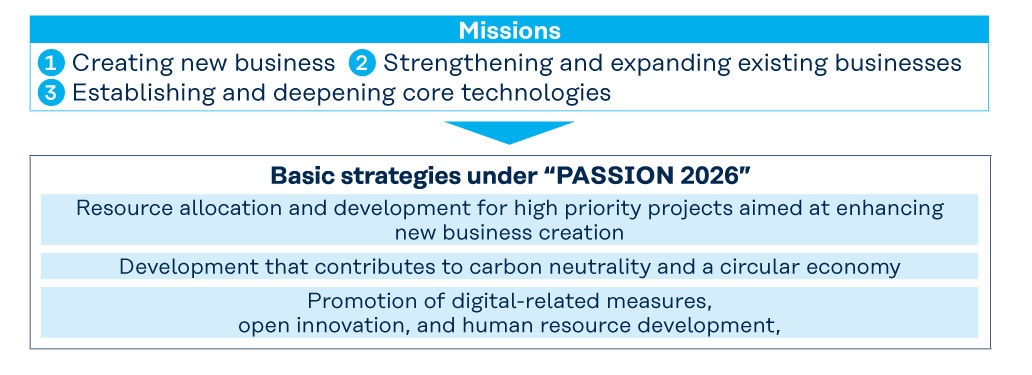Basic Policy
Competition is increasing in the chemicals industry due to the entry of companies from emerging countries, and the commoditization of specialty chemicals is also underway. Technological development capabilities to create value added products are increasing in importance as an essential management resource for maintaining and strengthening global competitiveness. The Research and Development Division promotes projects that contribute to Group-wide business expansion and profit growth under our three missions: “creating new business,” “strengthening and expanding existing businesses,” and “establishing and deepening core technologies.” Under the Medium-Term Management Plan “PASSION 2026”, the basic strategies of the Research and Development Division include “resource allocation and development for high priority projects aimed at enhancing new business creation,” “development that contributes to carbon neutrality and a circular economy,” and “promotion of digital-related measures, open innovation, and human resource development,” serving as foundations for the above. To facilitate the creation of new businesses, the Research and Development Division has teamed up with the Innovation Networking Center (INC) to promote global marketing for high priority projects, collaborative work to speed up development, and the creation of new business ideas. In the priority areas of carbon neutrality and a circular economy, we are focusing on utilization of biomass-derived raw materials and development of alternative technologies to PFAS (polyfluoroalkyl substances). Additionally, we will accelerate R&D through digital-related measures such as robotics and materials informatics (MI), the use of advanced simulation technology, the development of proprietary AI, and the pursuit of open innovation. Through these initiatives, we aim to generate new materials based on unique technologies and create new businesses for the future.


R&D Organization
Aiming to become a Specialty Chemical Company achieving sustained growth, the Research and Development Division plays a core role in implementing R&D and new business development activities as a corporate organization. We have two facilities, the Kurashiki Research Center and the Tsukuba Research Center, for the purpose of planning, proposing, and promoting R&D themes. In January 2025 we formed a Digital Solutions Department and External Collaboration Group to promote digital-related measures and open innovation which are key strategies of the Research and Development Division. To accelerate creation of new businesses in the life science field, which is one of our high priority projects, we upgraded the Life Innovation Promotion Group, into the Business Promotion Department, thereby fleshing out our global marketing structure. In addition, we established the Tokyo Lab within the Tokyo Women’s Medical University-Waseda University Joint Institution for Advanced Biomedical Sciences (known as TWIns) to promote open innovation in the life science field by enhancing customer solutions and accelerating collaboration between industry and academia
Development that Contributes to Sustainability
The Research and Development Division is focused on the creation of new materials and technologies that will enhance our medium- to long-term competitiveness by contributing to sustainability, and the creation of technologies and processes that address social concerns by helping to reduce GHG emissions. We consider carbon neutrality and a circular economy to be important themes, within which we are focusing our R&D efforts on four areas in particular: (1) raw material substitution, (2) reduction in environmental impact (via response to environmental regulations and opportunities), (3) recycling, and (4) reduction in GHG emissions.
Seizing the challenge of sustainability as an opportunity, the Kuraray Group will develop materials that contribute to improving the natural and living environments to deliver solutions to the world.
